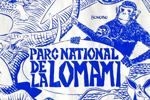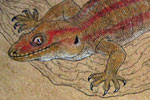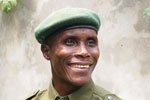
Close up of new species: lesula (Cercopithecus lomamiensis). This is a captive adult male. Photo courtesy of Hart et al.
In a massive, wildlife-rich, and largely unexplored rainforest of the Democratic Republic of the Congo (DRC), researchers have made an astounding discovery: a new monkey species, known to locals as the ‘lesula’. The new primate, which is described in a paper in the open access PLoS ONE journal, was first noticed by scientist and explorer, John Hart, in 2007. John, along with his wife Terese, run the TL2 project, so named for its aim to create a park within three river systems: the Tshuapa, Lomami and the Lualaba (i.e. TL2), a region home to bonobos, okapi, forest elephants, Congo peacock, as well as the newly-described lesula.
“There are monkeys out there between the three rivers that no one recognizes. They are not in our field guides,” Terese Hart wrote tantalizingly in a blog post in 2008. “We’ve sent photos to the most renown of African Primatologists. Result: a lot of raised eyebrows. And the more we find out the higher our eyebrows go.”
One of these monkeys was the lesula (Cercopithecus lomamiensis). John Hart first came across the new species in June 2007 when he and a field team were shown a captive baby lesula, kept as a pet by the local school director’s daughter in the remote village of Opala. The next step was locating the species in the wild.
 A lesula killed by an eagle. Notably, scientists were able to collect all their specimens of the new species from bushmeat hunters, in addition to this one which was seen killed by an eagle. In other words, no lesulas were killed specifically for the research. Photo by Gilbert Paluku. |
“This area is so remote that we are the first binocular sporting biologist to venture into the depth of the TL2,” John Hart writes, adding that any primate taken out of the forest “arrived as heavily smoked and unrecognizable bushmeat in centers like Kisangani.”
Six months after seeing the captive lesula, the team discovered them in the wild in an area known as Obenge.
“[The lesula] is shy and was the least frequently seen of all primates recorded on large mammal surveys (19 observations of Cercopithecus lomamiensis out of a total of 223 visual observations of primate groups),” the researchers write in the paper, noting that the species prefers old-growth rainforests.
The lesula is apart of the Cercopithecini family, which are commonly referred to as guenons. It’s most similar to the owl-faced monkey (Cercopithecus hamlyni), which is also found in the region. But the lesula sports a lighter coat and has unique calls. Genetic testing, furthermore, proves the species are distinct from each other and have likely been separated for a few million years, probably by impassable rivers.
| Related articles Innovative conservation: bandanas to promote new park in the Congo (07/16/2012) American artist Roger Peet is headed off to DRC to help survey a new protected area, Lomami National Park. With him, he’ll be bringing 400 bandanas sporting images of the park’s endangered fauna. Peet hopes the bandanas will not only create support and awareness for the fledgling park, but also help local people recognize threatened species. Militia massacres rangers, 13 endangered okapi at Congo wildlife reserve Unidentified poodle moth takes Internet by storm (08/29/2012) A white moth from Venezuela that bears a striking resemblance to a poodle has become an Internet sensation, after cryptozoologist Karl Shuker posted about the bizarre-looking species on his blog. Photographed in 2009 in Canaima National Park by zoologist Arthur Anker, the moth has yet to be identified and could be a species still unknown to science. ‘Penis snake’ discovered in Brazil is actually a rare species of amphibian (08/02/2012) A creature discovered by engineers building a dam in the Amazon is a type of caecilian, a limbless amphibian that resembles an earthworm or as some are noting, part of the male anatomy. The animal was discovered while draining a portion of the Madeira River for a controversial hydroelectric project. Little else is known about the species. Beyond Bigfoot: the science of cryptozoology (03/26/2012) Anyone who doubts cryptozoology, which in Greek means the “study of hidden animals,” should remember the many lessons of the past 110 years: the mountain gorilla (discovered in 1902), the colossal squid (1981), and the saola (1992) to name a few. Every year, almost 20,000 new species are described by the world’s scientists, and a new book by Dr. Karl Shuker highlights some of the most incredible and notable new animals uncovered during the past century. (10/21/2012) Species discovery: how do scientists find and describe new species—and the answer to other taxonomy questions. Unsung heroes: the life of a wildlife ranger in the Congo (11/01/2011) The effort to save wildlife from destruction worldwide has many heroes. Some receive accolades for their work, but others live in obscurity, doing good—sometimes even dangerous—work everyday with little recognition. These are not scientists or big-name conservationists, but wildlife rangers, NGO staff members, and low level officials. One of these conservation heroes is Bunda Bokitsi. |
The researchers estimate that the lesula habitat ranges around 17,000 square kilometers (6,500 square miles) in the TL2 area, and say the species is not “uncommon” in a region to date untouched by logging and mining. However, that doesn’t mean the species is secure. Like many of Africa’s primate, the lesula is imperiled by the bushmeat trade.
“For species with restricted ranges and reliance on primary forest, such as [the lesula], uncontrolled hunting can lead to catastrophic declines over a short period,” the scientists write. The researchers suggest that the lesula be listed as Vulnerable by the IUCN Red List, due to a likely decline from “uncontrolled” bushmeat hunting.
With the goal of conserving this still untouched forest and its abundant wildlife (see list below), John and Terese Hart have kick-started the TL2 project and begun working with the DRC government and local communities on establishing a 9,000 square kilometer (3,470 square miles) protected area known as Lomami National Park in the region. In total, TL2 covers about 60,000 square kilometers (23,000 square miles), or an area about twice the size of Belgium.
“While the establishment of the new protected area is a necessary first step, active protection and monitoring are required to ensure the conservation of the lesula and other unique biodiversity of the eastern rim of Congo’s central basin,” the researchers write. For their parts, the Harts have been active in working with authorities to combat illegal poaching in the region.
In all the TL2 region is home to eleven primates, including four that are endemic to the area: Lomami River red colobus (Procolobus badius
parmentieri), Lomami River blue monkey (Cercopithecus mitis heymansi), and Kasuku River Wolf’s monkey (Cercopithecus wolfi elegans), and, of course, the lesula. But what first brought the Harts there was the bonobos, great apes that are closely related to chimpanzees but have unique social structures.
The discovery of a new primate species is rare nowadays, and when discoveries are made they are usually in the Amazon or Southeast Asia. In fact, the lesula is only the second newly discovered monkey in Africa in the past 28 years; the other was the kipunji (Rungwecebus kipunji) in Tanzania. Described in 2005, the kipunji is currently listed as Critically Endangered.

Juvenile lesulas. Photo courtesy of Hart et al.

Left: adult male. Right: young female. Photo courtesy of Hart et al.

Left: the owl-faced monkey (Cercopithecus hamlyni). Photo by: Noel Rowe. Right: adult lesula. Photo courtesy of Hart et al.
CITATION: Hart JA, Detwiler KM, Gilbert CC, Burrell AS, Fuller JL, et al. (2012) Lesula: A New Species of Cercopithecus Monkey Endemic to the Democratic Republic of Congo and Implications for Conservation of Congo’s Central Basin. PLoS ONE 7(9): e44271. doi:10.1371/journal.pone.0044271
Some endangered wildlife of TL2
Black crested mangabey (Lophocebus aterrimus), Near Threatened
Bonobo (Pan paniscus), Endangered
Congo peacock (Afropavo congensis), Vulnerable
Forest elephant (Loxodonta cyclotis), lumped with savannah elephant: Vulnerable
Hippopotamus (Hippopotamus amphibius), Vulnerable
Leopard (Panthera pardus), Near Threatened
Lowland bongo (Tragelaphus eurycerus eurycerus), Near Threatened
Okapi (Okapia johnstoni), Near Threatened
Western red colobus (Procolobus badius), Endangered
Related articles
Nintendo is ‘worst’ company on conflict minerals
(08/16/2012) Gaming giant Nintendo is the worst company for ensuring that materials used in its electronics are not linked to bloodshed in war-torn regions like the Democratic Republic of the Congo (DRC), according to an assessment released today by the Enough Project, an initiative that aims to boost transparency around minerals sourcing.
Turning gorilla poachers into conservationists in the Congo [warning: graphic photos]
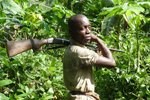
(08/13/2012) Although founded only four years ago, Endangered Species International-Congo, has ambitious plans to protect dwindling Western gorilla populations and aid local people in the Republic of the Congo. The organization, an offshoot of Endangered Species International (ESI), has been spending the last few years studying the bushmeat trade in Pointe-Noire, the country’s second largest city, and developing plans for turning hunters into conservationists.
Poacher known as ‘Morgan’ behind devastating massacre at Okapi Wildlife Reserve
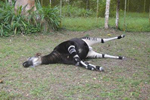
(07/05/2012) Officials have pointed to an infamous elephant poacher known as ‘Morgan’ as the head of the murderous attack at the Okapi Wildlife Reserve station in the Democratic Republic of the Congo (DRC) late last month. The attack by Morgan and his crew left seven people dead, including two wildlife rangers. The poachers also shot dead 13 captive okapis at the headquarters, which were considered ambassadors for the imperiled forest. One okapi remains alive, but injured and conservationists are not optimistic about its survival. UNESCO and the the NGO Fauna and Flora international have issued an emergency appeal to raise $120,000 dollars within two weeks for the victim’s families as well as for rapidly rebuilding the station.
10,000 sq mi of Congo rainforest declared World Heritage site
(07/02/2012) Central Africa has the newest World Heritage site.
Elephant numbers halved in Central Africa in 5 years
(06/08/2012) Elephant numbers in areas surveyed by the Wildlife Conservation Society (WCS) in Central Africa halved between 2006 and 2011, hinting at the carnage wrought by the surging commercial ivory trade and demonstrating a need to boost protection efforts, said the Bronx Zoo-based conservation group.
Congolese experts needed to protect Congo Basin rainforests
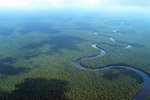
(06/20/2012) This summer, the Democratic Republic of Congo (DRC) is expected to approve a new higher education strategy which the country has developed with the World Bank and other international donors. The shape of this educational reform initiative will be critical to Congo’s future in many ways. It could finally offer Congo’s long-suffering people a route into the 21st century. It will also help determine the future of the DRC’s forests. Nearly half of the Congo Basin’s remaining rainforest is in the DRC—yet the critical role of Congolese experts in forestry, agricultural science, wildlife management and other rural sciences in protecting this forest is not widely recognized.
Deforestation increases in the Congo rainforest
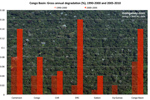
(03/20/2012) Deforestation in the Congo Basin has increased sharply since the 1990s, reports an extensive new assessment of forests in the six-nation region. Released by the Central African Forests Commission (COMIFAC) and members of the Congo Basin Forest Partnership, The State of the Forest finds that the region’s annual gross deforestation rate doubled from 0.13 percent to 0.26 percent between the 1990s and the 2000-2005 period. Gross degradation caused by logging, fire, and other impacts increased from 0.07 percent to 0.14 percent on an annual basis. Despite the jump, rates in the Congo Basin remain well below those in Latin America and Southeast Asia, but the region is seen as a prime target for future agroindustrial expansion.
Majority of protected tropical forests “empty” due to hunting
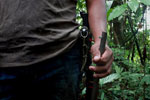
(02/08/2012) Protected areas in the world’s tropical rainforests are absolutely essential, but one cannot simply set up a new refuge and believe the work is done, according to a new paper in Bioscience. Unsustainable hunting and poaching is decimating tropical forest species in the Amazon, the Congo, Southeast Asia, and Oceana, leaving behind “empty forests,” places largely devoid of any mammal, bird, or reptile over a few pounds. The loss of such species impacts the whole ecosystems, as plants lose seed dispersers and the food chain is unraveled.
Elephants: the gardeners of Asia’s and Africa’s forests
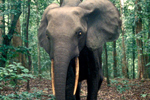
(04/25/2011) It seems difficult to imagine elephants delicately tending a garden, but these pachyderms may well be the world’s weightiest horticulturalist. Elephants both in Asia and Africa eat abundant amounts of fruit when available; seeds pass through their guts, and after expelled—sometimes tens of miles down the trail—sprouts a new plant if conditions are right. This process is known by ecologists as ‘seed dispersal’, and scientists have long studied the ‘gardening’ capacities of monkeys, birds, bats, and rodents. Recently, however, researchers have begun to document the seed dispersal capacity of the world’s largest land animal, the elephant, proving that this species may be among the world’s most important tropical gardeners.
